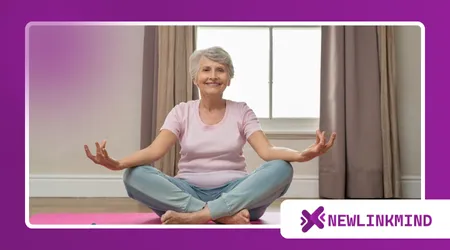Yoga for Seniors with Knee Pain: Best Moves to Strengthen and Protect

Yoga for Seniors with Knee Pain. Traditional exercises can sometimes exacerbate existing knee issues due to high impact or quick movements.
Anúncios
Yoga provides a low-impact alternative focusing on building foundational strength and improving flexibility.
It meticulously strengthens the muscles surrounding the knee, which are the real pillars of support.
This targeted approach significantly alleviates pressure directly on the joint capsule.
Furthermore, yoga improves proprioception—the body’s spatial awareness. Better body awareness naturally leads to safer movement patterns, preventing undue strain.
Anúncios
This mindful quality is what sets it apart from simply repetitive exercise routines.
How Does Strengthening Support the Knee Joint? Yoga for Seniors with Knee Pain
The knee is a complex hinge, vulnerable when the muscles around it are weak or imbalanced.
Weak quadriceps, hamstrings, and especially the glutes, force the knee to absorb excessive shock. Conversely, strong surrounding musculature acts like a natural suspension system.
Anúncios
When these muscles are strong, they stabilize the kneecap and maintain proper tracking.
This creates a dynamic shield, ensuring the bones and cartilage move with greater ease and less friction. What’s the point of focusing on the joints if the muscles aren’t doing their job?
What Are the Best Knee-Friendly Yoga Poses for Seniors?
The best poses for painful knees prioritize safe alignment and controlled engagement over deep flexion or strenuous bearing.
Read more: Partner Yoga: Fun and Connection
Always remember: listen intently to your body; pain is the signal to back off immediately. Using props like blocks, chairs, and straps makes many poses accessible and safer.
| Pose (Asana) | Primary Benefit | Key Modification for Knee Pain |
| Bridge Pose (Setu Bandhasana) | Strengthens Glutes and Hamstrings | Place a block between the thighs and press gently to engage inner legs; avoid pushing hips too high. |
| Reclining Hand-to-Big-Toe (Supta Padangusthasana) | Stretches Hamstrings and Calves | Keep the bottom leg bent with the foot flat on the floor; use a strap around the lifted foot. |
| Chair Pose (Utkatasana – Modified) | Builds Quadriceps Strength | Only sit as low as a comfortable chair; use a wall for back support to control the descent. |
| Mountain Pose (Tadasana) | Improves Alignment and Posture | Focus on grounding all four corners of the feet; ensure knees are soft, not locked. |
Consider the simple analogy of a sailboat’s mast and rigging: the knee is the mast, and the surrounding muscles are the rigging.
If the ropes are slack, the mast wobbles under stress; if they are taut and balanced, the mast remains steady.

How Can I Modify Standing Poses for Safety and Support? Yoga for Seniors with Knee Pain
Many traditional standing poses, like Warrior II, become entirely accessible with intelligent modification.
Instead of relying solely on the front bent knee, you can decrease the bend’s depth.
Place a chair in front of you for hand support, significantly reducing the load on your legs. A good practice is to imagine you are only ‘sitting’ halfway down in the pose.
See how interesting: How Yoga Promotes Independence
Take a look at Warrior II (Virabhadrasana II): if your front knee aches, narrow your stance.
Furthermore, make sure the knee tracks precisely over your ankle, not collapsing inward or outward.
This tiny adjustment can make all the difference in achieving Yoga for Seniors with Knee Pain: Best Moves to Strengthen and Protect safely.
What Real-World Evidence Supports Yoga for Knee Pain?
The benefits of yoga for joint health are not merely anecdotal; they are strongly supported by medical research.
A systematic review and meta-analysis published in PLOS ONE involving multiple randomized controlled trials reported significant findings.
Check this out: Morning Meditation When You Have Zero Time
Specifically, it concluded that yoga intervention for patients with knee osteoarthritis (KOA) “showed significant improvements in alleviating pain and stiffness” and “can also improve the physical function of patients.”
This robust finding underscores yoga as a scientifically validated therapeutic exercise. Is it not time to acknowledge the power of movement as medicine, backed by evidence?
The Power of Quadriceps Engagement
Many seniors find ascending stairs challenging due to diminished quad strength. A modified Chair Pose, performed using a sturdy wall, directly addresses this.
Stand with your back against a wall, then slowly slide down only a few inches until you feel a gentle quad engagement. Hold for a count of five.
This simple movement, repeated, rebuilds the functional power needed for daily tasks. This is not about deep squats; it is about controlled, therapeutic isometric holds.
Releasing the Tight Hamstrings
Tight hamstrings can pull on the knee joint, increasing tension and pain.
The Reclining Hand-to-Big-Toe Pose is a perfect solution because it removes gravity and weight-bearing stress.
Lying on your back, you use a strap to gently pull the straight leg toward your chest, feeling a safe stretch behind the thigh.
Keeping the opposite leg bent and grounded stabilizes the pelvis, isolating the stretch effectively.

What is the Overall Impact of Consistent Practice?
Beyond pain reduction, consistent, gentle yoga improves balance, a crucial factor in fall prevention for seniors.
According to a 2024 report by the Centers for Disease Control and Prevention (CDC), falls are a leading cause of injury and death among older Americans, with 1 in 4 Americans aged 65+ reporting a fall each year.
Improving balance through postures like Mountain Pose significantly mitigates this risk.
Yoga provides a holistic intervention that simultaneously tackles pain, weakness, and instability.
The core philosophy of Yoga for Seniors with Knee Pain: Best Moves to Strengthen and Protect is to embrace your current capability, not mourn past abilities.
It is about progress, not perfection. Commit to this gentle practice, and you will discover a renewed sense of confidence and freedom in your movement.
Frequently Asked Questions
Is it safe to do yoga if my knee pain is due to severe arthritis?
Yes, generally, but extreme caution is required. Always consult your orthopedic specialist or physical therapist before starting.
Modified, chair-based, or gentle restorative yoga is often recommended to maintain range of motion without bearing weight.
How many times a week should a senior with knee pain practice yoga?
Consistency is more important than intensity. Start with two to three times a week for 20-30 minutes. Listen to your body and prioritize gentle, safe movements every time.
Should I avoid poses that involve bending the knee?
No, avoiding all bending weakens the muscles further.
Instead, perform poses that bend the knee with minimal or no weight-bearing, such as Bridge Pose or gentle Knee-to-Chest poses while lying down.
Only bend to a depth that feels comfortable, avoiding sharp pain.
++ Evidence-Based Yoga Poses to Support Knee Health and Recovery
